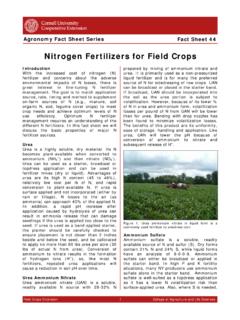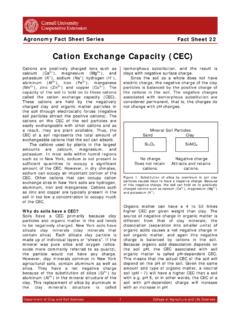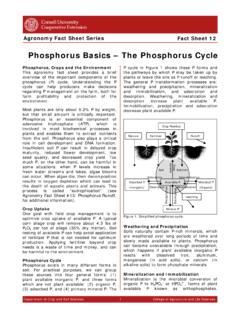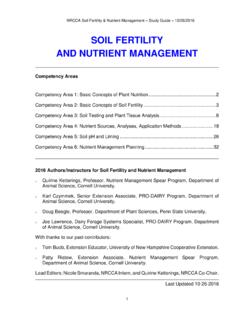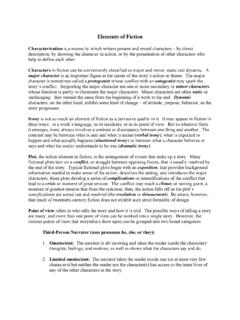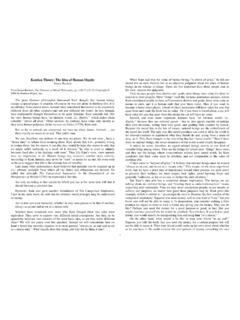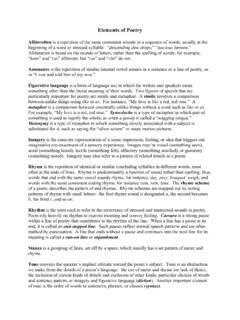Transcription of The Carbon Cycle and Soil Organic Carbon
1 Fact Sheet 91 The Carbon Cycle and Soil Organic Carbon Agronomy Fact Sheet Series Field Crops Extension 1 College of Agriculture and Life Sciences Carbon and the Carbon Cycle Carbon (C) is one of the most common elements in the universe and found virtually everywhere on earth: in the air, the oceans, soil, and rock. Carbon is part of geologic history in rock and especially the ancient deposits that formed coal, oil and other energy sources we use today.
2 Carbon is also an essential building block of life and a component of all plants and animals on the planet. It has unique bonding properties that allow it to combine with many other elements . These properties enable the formation of molecules that are useful and necessary to support life. The role of Carbon in living systems is so significant that a whole branch of study is devoted to it: Organic chemistry. Carbon that is not tied up in rock or deep in the oceans is constantly changing and moving.
3 This process is called the Carbon Cycle (Figure 1). Soil holds the largest portion of active Carbon on earth. Plants take Carbon from the air and convert it to plant tissue, some of which returns to the soil as plant residue. Agriculture s Role in the Carbon Cycle Carbon is critical to soil function and productivity, and a main component of and contributor to healthy soil conditions. Soil management plays a critical role in whether the Carbon remains in the soil or is released to the atmosphere.
4 Agricultural practices can impact both the amount and the composition of soil Organic Carbon and hence also the soil s physical, biological, and chemical condition, the combination of things that defines soil health. Farm practices that affect Carbon therefore impact agricultural productivity and resilience (the soil s ability to deal with weather extremes) and the Carbon Cycle itself. Importance of Soil Organic Carbon While the agricultural sector has the ability to impact the Carbon Cycle on a large scale, often through the release of Carbon , farmers have a vested interest in retaining and increasing soil Organic Carbon for individual fields because soil and yield tend to improve when the soil Organic Carbon level increases.
5 Higher soil Organic Carbon promotes soil structure or tilth meaning there is greater physical stability. This improves soil aeration (oxygen in the soil) and water drainage and retention, and reduces the risk of erosion and nutrient leaching. Soil Organic Carbon is also important to chemical composition and biological productivity, including fertility and nutrient holding capacity of a field. As Carbon stores in the soil increase, Carbon is sequestered , and the risk of loss of other nutrients through erosion and leaching is reduced.
6 An increase in soil Organic Carbon typically results in a more stable Carbon Cycle and enhanced overall agricultural productivity, while physical disturbances of the soil can lead to a net loss of Carbon into the surrounding environment due to formation of Carbon dioxide (CO2). Figure 1. The Carbon Cycle and the interaction of plant, soil, and atmosphere. Adapted from Institute for Radiological Protection and Nuclear Safety (IRSN). Management Practices for C Sequestration With agricultural productivity so dependent on soil Organic Carbon and Carbon cycling, how can we best manage fields to enhance soil Organic Carbon levels while also reducing Carbon loss into the atmosphere?
7 Atmosphere Soil Humified substances Microbial biomass Mineralization Root respiration Root incorporation Carbon dioxide emission from soil Photosynthesis Respiration Food chain Plant biomass Animal biomass Wet Organic material CO2 Atmospheric CO2 CaCO3 <-> H2CO3 Field Crops Extension 2 College of Agriculture and Life Sciences The ability of agricultural fields to sequester Carbon (capture and storage of Carbon that would otherwise be lost to the environment) depends on several factors including climate, soil type, type of crop or vegetation cover, and management practices.
8 Employing farming practices that reduce disturbance of the soil (less aeration from tillage helps protect Carbon ), combined with practices that bring additional Carbon to the soil, will allow for Carbon sequestration over time. Such practices include implementation of conservation tillage (no-till, zone-till, minimum-till, shallow mixing or injection for manure applications), retaining crop residues, including cover crops in crop rotations, adding Organic nutrient sources such as manure and compost, and including perennial crops in crop rotations (Table 1).
9 Their implementation may slow or even reverse the loss of Carbon from agricultural fields, improve nutrient cycling and reduce nutrient loss. Conclusion Soil Carbon management is an important strategy for improving soil quality, increasing crop yields, and reducing soil loss. Capturing Carbon in the soil helps improve soil health and productivity, and stabilize the global Carbon Cycle , benefiting agricultural production. Additional Resources o United State Environmental Protection Agency (USEPA).
10 Agricultural sector emissions. Sources of greenhouse gas emissions: o NASA Earth Observatory. The Carbon Cycle : o Cornell Nutrient Management Spear Program Agronomy Fact Sheet #41: Soil Organic Disclaimer This fact sheet reflects the current (and past) authors best effort to interpret a complex body of scientific research, and to translate this into practical management options. Following the guidance provided in this fact sheet does not assure compliance with any applicable law, rule, regulation or standard, or the achievement of particular discharge levels from agricultural land.
